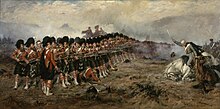Colin Campbell, 1st Baron Clyde

Colin Campbell, 1st Baron Clyde , GCB , KSI (born October 20, 1792 in Glasgow , † August 14, 1863 in Chatham ) was a British field marshal . He was in command of the suppression of the Sepoy uprising in India.
Life
Campbell was born the son of carpenter Macliver and was initially trained at Gosport Military School. Here he exchanged his father's name for his mother's (Campbell). In 1808 he acquired a patent as an Ensign in the 9th Regiment of Foot . In the same year he took part in the Napoleonic Wars on the Iberian Peninsula under General Ballesteros in Portugal . He fought in the battles of Vimeiro and La Coruña , among others . In 1809 he took part in the Walcheren expedition . In the following years he fought as a company commander in the Battle of Barrosa , the Battle of Vitoria and the Siege of San Sebastián . He was wounded several times in these fights. On November 3, 1813, he was promoted to captain .
He spent the following years in various colonies in Great Britain. He took part in the British-American War in Nova Scotia in 1812 . He was later aide-de-camp for the governor of Demerara . In 1835 he took command of the 98th Regiment of Foot with the financial support of friends . He led this in 1842 as a lieutenant colonel in the First Opium War against China . In 1848/49 he led the 3rd Division of the Punjab Army in the Second Sikh War in India . Campbell played a decisive role in the victory in the Battle of Chillianwala and brought about the complete defeat of the enemy at Gujrat . For this he was knighted on June 5, 1849 as Knight Commander of the Order of the Bath . He remained in India until 1852, where he led the difficult Peshawar command on the North West Frontier and carefully directed operations against the hill tribes.
At the beginning of the Crimean War , Campbell rose to major general and led the Highland Brigade in the Crimea . With this he hurried to the aid of the beleaguered General Brown in the battle of the Alma , threw back the Russian troops and stormed the nearby hills. In the Battle of Balaklava on October 25, 1854, after the defeat of the Turks, he repulsed the attack of the enemy cavalry . With the words "There is no retreat from here, men!" he formed his men into the thin red line ( "The Thin Red Line" ) , which has become famous for the color of their uniform . This situation was later recorded in the picture of the same name by Robert Gibb and entered English usage as a synonym for holding out against a superior force.
On July 5, 1855 he was raised to the Knight Grand Cross of the Order of the Bath. In 1856 Campbell was appointed lieutenant general and inspector general of the infantry .
After the outbreak of the Sepoy uprising in India, Lord Palmerston offered him on July 11, 1857 supreme command of the troops there. He left England the next evening and reached Calcutta on August 13th . He could the besieged city with his troops in mid-November Lucknow shock and evacuate the crew, including civilians. In March 1858 he liberated Lucknow and entered Bareli on May 7th . In November he drove the last remnants of the rebels across the border into Nepal .
For his achievements he received on August 16, 1858 the thanks of Parliament and the dignity of a peer with the title Baron Clyde , of Clydesdale in Scotland. On June 25, 1861 he was accepted as a Knight Companion in the Order of the Star of India . On November 9, 1862 he was promoted to field marshal .
Campbell died in Chatham on August 14, 1863. He was buried in Westminster Abbey in London . Since he was never married and had no offspring, the title of Baron Clyde expired on his death.
literature
- James MacLiver Roy: “Old take care”. The story of Field Marshal Sir Colin Campbell, Lord Clyde. Self-published, Glasgow 1987.
- Clyde, Colin Campbell, Baron . In: Encyclopædia Britannica . 11th edition. tape 6 : Châtelet - Constantine . London 1910, p. 571 (English, full text [ Wikisource ]).
Individual evidence
- ^ William Arthur Shaw: The Knights of England. Volume 1, Sherratt and Hughes, London 1906, p. 238.
- ^ William Arthur Shaw: The Knights of England. Volume 1, Sherratt and Hughes, London 1906, p. 191.
- ^ The London Gazette : 22171, 3667 , August 6, 1858.
- ^ William Arthur Shaw: The Knights of England. Volume 1, Sherratt and Hughes, London 1906, p. 306.
| personal data | |
|---|---|
| SURNAME | Campbell, Colin, 1st Baron Clyde |
| ALTERNATIVE NAMES | Clyde, Colin Campbell, 1st Baron |
| BRIEF DESCRIPTION | British Field Marshal |
| DATE OF BIRTH | October 20, 1792 |
| PLACE OF BIRTH | Glasgow |
| DATE OF DEATH | August 14, 1863 |
| Place of death | Chatham |
